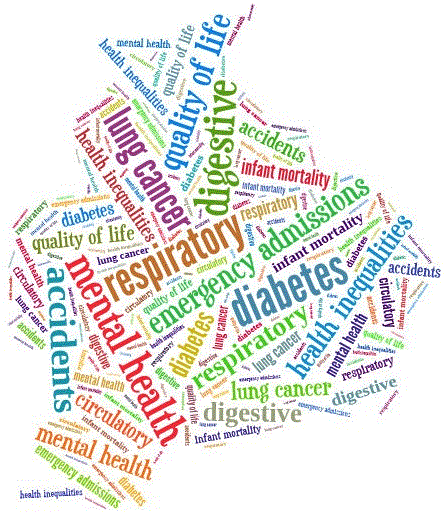Health inequalities summary
Significant inequalities in health are present within the Lancashire-14.  These health inequalities prevent too many of Lancashire's citizens from benefiting from the opportunities, such as working, learning, making the most of leisure time and keeping in touch with family and friends, that many of us take for granted.
These health inequalities prevent too many of Lancashire's citizens from benefiting from the opportunities, such as working, learning, making the most of leisure time and keeping in touch with family and friends, that many of us take for granted.
The Covid-19 pandemic will have an impact on inequalities, not just in Lancashire, and further analysis is likely to be needed over the coming years.
Health inequalities in Lancashire-14 JSNA analysis 2014
Our thematic JSNA for health inequalities in Lancashire-14 provides analysis of inequalities in health and the causes of poor health, between deprivation groups within Lancashire-14. As a revision of the original health inequalities JSNA completed in 2009, this report not only gives us a picture of health inequalities now, but of how health inequalities in Lancashire-14 are changing over time.
The health inequalities reference group agreed on the new top ten goals for health equity in Lancashire-14 and these are listed further below. Three overarching themes can be used to summarise the ten:
- premature mortality (dying before the age of 75);
- mental health and wellbeing; and
- unplanned hospitalisation.
The ten goals for health equity are set out below.
Goal 1 - narrow the gap in diabetes
Those in the most deprived areas are over seven times as likely to die prematurely from diabetes as those in the least deprived areas.
Goal 2 - narrow the gap in respiratory disease
Those in the most deprived areas are over four and a half times as likely to die prematurely from chronic obstructive pulmonary disease as those in the least deprived areas.
Goal 3 - narrow the gap in digestive disease
Those in the most deprived areas are over three times as likely to die prematurely from chronic liver disease as those in the least deprived areas.
Goal 4 - narrow the gap in mental health problems
Those in the most deprived areas are three times as likely to suffer from extreme anxiety and depression as those in the least deprived areas.
Goal 5 - narrow the gap in lung cancer
Those in the most deprived areas are over two and a half times as likely to die prematurely from lung cancer as those in the least deprived areas.
Goal 6 - narrow the gap in circulatory disease
Those in the most deprived areas are over two and a half times as likely to die prematurely from coronary heart disease, and over twice as likely to die prematurely from stroke as those in the least deprived areas.
Goal 7 - narrow the gap in deaths from accidents
Those in the most deprived areas are over twice as likely to die prematurely as a result of an accident as those in the least deprived areas.
Goal 8 - narrow the gap in quality of life
Those in the most deprived areas are over twice as likely to experience extreme pain and discomfort and over one and a half times as likely to have problems with mobility, self-care and performing usual activities as those in the least deprived areas.
Goal 9 - narrow the gap in unplanned hospital admissions
Those in the most deprived areas are over one and a half times as likely to be admitted to hospital in an emergency as those in the least deprived areas.
Goal 10 - narrow the gap in infant mortality
In the most deprived areas, babies up to one year old are over one and a half times as likely to die as those in the least deprived areas.
Changes since 2009
The gap in early death from diabetes has widened between 2009 and 2012 and the gap in some of the important causes of health inequalities such as income, fuel poverty and drinking alcohol at levels hazardous to health have also widened over the last three years. On the other hand, some health inequalities in Lancashire-14 do seem to be reducing. The gaps in anxiety and depression and early deaths from heart disease and stroke have narrowed; with rates in the most deprived parts of the population improving faster than the least deprived. This shows that it is possible to narrow the health gap with concerted co-ordinated efforts across partner organisations.
Call for action for health equity
Inequalities in health outcomes place a significant burden on Lancashire's health system and policy makers and commissioners should aim to put in place programmes of activity to address the wider social and economic determinants of health that will narrow the internal health gap and take account of the likely future health needs of the population. The government's local action on health inequalities resources provide evidence and examples of practical action that can be taken at a local level to reduce health inequalities. We also want to encourage others living and working in Lancashire-14 to use the findings from the Lancashire-14 health inequalities JSNA to develop their own ideas and plans to create health equity. Everybody in Lancashire has an important role to play in tackling health inequalities.
DataAppendices (XLSM 145 KB) |
Page updated October 2021